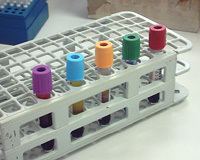 | ||
A Vacutainer blood collection tube is a sterile glass tube with a colored rubber stopper creating a vacuum seal inside of the tube facilitating the draw of a predetermined volume of liquid. Most commonly used to collect blood samples in venipuncture, serum separator tubes. Vacutainer tubes may contain additives designed to stabilize and preserve the specimen prior to analytical testing. Tubes are available with a safety-engineered closure (rubber stopper), with a variety of labeling options and stopper colors as well as a range of draw volumes.
Contents
- Principles
- Contents of tubes
- Containers containing coagulants
- Containers containing anticoagulants
- Other
- History
- Culture
- References
Vacutainer tubes were invented by Joseph Kleiner and Becton Dickinson in 1949. Vacutainer is a registered trademark of Becton Dickinson, which manufactures and sells the tubes today.
Principles
The vein is first punctured with the hypodermic needle which is carried in a translucent plastic holder. The needle is double ended, the second shorter needle being shrouded for safety by the holder. When a Vacutainer test tube is pushed down into the holder, its rubber cap is pierced by the second needle and the pressure difference between the blood volume and the vacuum in the tube forces blood through the needle and into the tube. The filled tube is then removed and another can be inserted and filled the same way. It is important to remove the tube before withdrawing the needle, as there may still be some suction left, causing pain upon withdrawal.
The test tubes are covered with a color-coded plastic cap. They often include additives that mix with the blood when collected (see below), and the colour of the tube's plastic cap indicates which additives that tube contains.
The plastic caps are opaque for tubes with a normal vacuum. Translucent-topped tubes contain a weaker vacuum in the same sized tube, and will obtain less blood. The weaker suction makes them more suitable for smaller sized veins, because the standardised suction of the tubes may cause the veins of elderly people or those with delicate veins to collapse. In this case a syringe should be used instead.
Contents of tubes
The tubes may contain additional substances that preserve the blood for processing in the medical laboratory. Using the wrong tube may therefore make the blood sample unusable. These substances are typically a thin film coating that is applied using an ultrasonic nozzle, a video of the process can be seen here: Blood Collection Tube Coating Video.
The substances may include anticoagulants (EDTA, sodium citrate, heparin) or a gel with intermediate density between blood cells and blood plasma. Additionally, some tubes contain substances that preserve certain chemicals or substances within the blood, such as glucose. When the tube is centrifuged, the blood cells sink to the bottom of the tube, are covered by a layer of the gel, and the serum is left on top. The gel enables the tube to be tipped upside-down and transported without the blood cells remixing with the serum. When a tube that contains an anticoagulant is centrifuged, the clear liquid is plasma, which contains the clotting factors.
The meaning of the different colors are standardized across manufacturers.
The order of draw refers to the sequence in which these tubes should be filled. The needle which pierces the tubes can carry additives from one tube into the next, and so the sequence is standardized so that any cross-contamination of additives will not affect laboratory results.
Containers containing coagulants
Containers containing anticoagulants
Other
History
It was developed in 1947 by Joseph Kleiner, and is currently marketed by Becton, Dickinson and company.
The plastic version, known as Vacutainer PLUS, was developed at Becton Dickinson Research Center, RTP, NC in 1991-1993, by co-inventors E. Vogler, D. Montgomery and G. Harper amongst others of the Surface Science Group as US patents 5344611, 5326535, 5320812, 5257633 and 5246666.
Vacutainer is now commonly used in phlebotomy and bloodletting process.
Culture
The purple top tube became an issue in the O.J. Simpson murder case when the defense alleged that small droplets of blood found at the crime scene contained the preservative EDTA; had this been true, it would have meant that the droplet might have been taken from the purple top tube used to collect Simpson's blood and planted at the crime scene.
